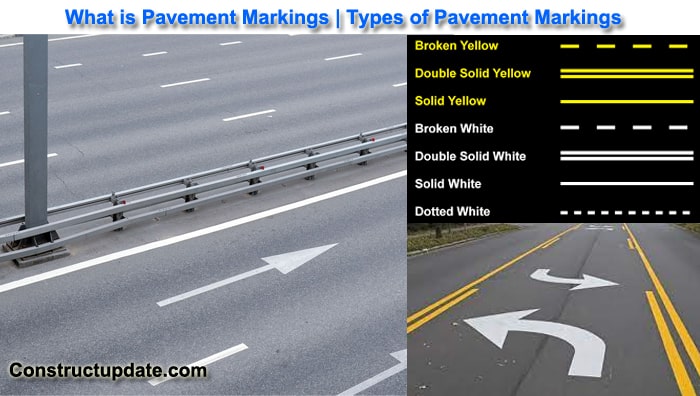What is Pavement Markings | Pavement Marking Types, Colors, and Meaning
Pavement markings, also known as road markings, are a part of the intelligence system for road users. In addition to road signs and signals, pavement markings direct drivers where to park their cars, warn them of impending dangers, and pinpoint where conveying is allowed.
The majority of road markings are white or yellow in hue. Other hues are available, but the most common are white and yellow, which you should be familiar with for your written DMV test and permit practice.
To be correct, pavement markings must be visible and understandable. A consistent system of marking color, form, and application has been developed to convey the same message every time a pavement marker is encountered.
All surface markings should be kept in good condition to guarantee adequate visibility during the day and at night. It is the obligation of a municipality to keep a branding system up to date once one has been installed.

The Meaning of the Different Colors Used in Pavement Marking
- White:
It defines the right edge of the route by separating cars driving in the same direction. - Yellow:
It differentiates two-way left-turn lanes and reversible lanes from other lanes by separating traffic flows in opposite directions and defining the left edge of divided/one-way motorways and ramps. - Blue:
It can be used to augment white handicap parking marks. - Purple:
Toll plaza approach lane lines or edge lines controlled for registered electronic toll collection vehicles can be augmented. - Black:
For light-colored pavements with insufficient contrast, it is used in conjunction with other pavement markings (yellow, white, red, blue, purple).
The Different Types of Pavement Markings and What They Mean?
The following are the various types of pavement markings that are utilised.
A. Longitudinal Markings
B. Yellow Road Lines
C. White Lane Line Pavement Markings
D. Edge Line Pavement Markings
E. Raised Pavement Markers (Rpm)
F. No-Passing Zones
A. Longitudinal Pavement Marking
Longitudinal pavement markings are lines that run parallel to the flow of traffic to show where a driver should be on the road.
They are either continuous or broken lines that divide the road into two equal half. They denote that traffic from one side should not cross over to the other (except in case of broken lines)
Markings for Traffic Lanes: Lane markers are often broken white lines that divide the road into lanes of 3.5 meters each.
Solid lines, generally in white or yellow, are drawn along the road shoulders as a border or edge lines. They indicate the edge of the road carriageway.
Bus Lane Markings: The carriageway’s rightmost lane is designated for heavy vehicles such as buses and trucks.
B. Yellow Road Lines
Traffic driving in opposite directions is separated by yellow lines.
a) Broken Yellow Line
You may cross broken yellow lines to pass a car in front of you if it is safe to do so. Before passing, double-check that the road ahead is clear.
b) Solid Yellow Line
The presence of a solid yellow line implies that passing is not permitted. To pass another vehicle, do not cross a solid yellow line.
c) A Solid Yellow Line Alongside a Broken Yellow Line
You may or may not be able to pass depending on whose side you are on:
If it is safe, you may cross the lines to pass vehicles if you are traveling on the right side of the broken yellow line.
You must not pass on the side of the solid yellow line if you are traveling.
d) Double Solid Yellow Lines
- No passing from either lane is indicated by two solid yellow lines. Only drive to the left of double solid yellow lines if the following conditions apply:
- To enter or depart a road, turn left.
- Your lane is barred or closed, and you must drive on the opposite side of the lines, according to signage.
- Using an HOV lane with an authorised entrance on the left side of the lines
C. White Lane Line Pavement Markings
- White Lane marking for Same Direction of Travel
- Broken White Line – Vehicles May Change Lane
White pavement markings demarcate traffic lanes that travel in the same direction. These markings should be placed on the pavement in the same direction as two or more adjacent traffic lanes (unless required for reversible lanes).
Lane line-markings should also be utilised in overcrowded areas, with lane line markings on more traffic lanes than lanes without markings. A regular broken white line will be included in these lane line markings, with the exception of areas where crossing the lines is permitted.
D. Edge Line Pavement Markings
The road’s margins are marked by edge line pavement markings. They can be utilised as visual references in low-visibility situations. Edge lines should never be crossed at large crossroads or driveways.
On divided highways, one-way streets, and ramps, standard solid yellow lines can be used to delineate the left side of the road or to denote limitations to the left of these markers.
E. Raised Pavement Markings (Rpm)
For roadway pavement markings, raised pavement markings can be added or removed. Along prismatic cube-corner reflectors utilised for necessary retroreflective qualities, these can be retroreflective or non-retroreflective.
Raised pavement markers will improve visibility in bad weather, be more durable than markings, provide tactile warnings, and serve as transverse rumble strips.
F. No-Passing Zones
No-passing zones must be implemented on two- and three-lane highways where engineering studies show that passing must be prohibited owing to insufficient sight distance or other unique circumstances.
Locations of Common No-Passing Zones
Transitions from one lane to another.
- Obstruction is on its way.
- Crossings of grades.
- Crossings of the highway and the railroad.
- Locations with insufficient sight distance.
The uniform traffic control devices manual mandates the use of one-direction or two-direction no-passing zone pavement markings. In addition to markings, no-passing zone signage may be used to preserve the limits of a no-passing zone.
The traffic near the split line is permitted, however the traffic adjacent to the strong line is prohibited. Two straight yellow lines prohibit passing in both directions.





